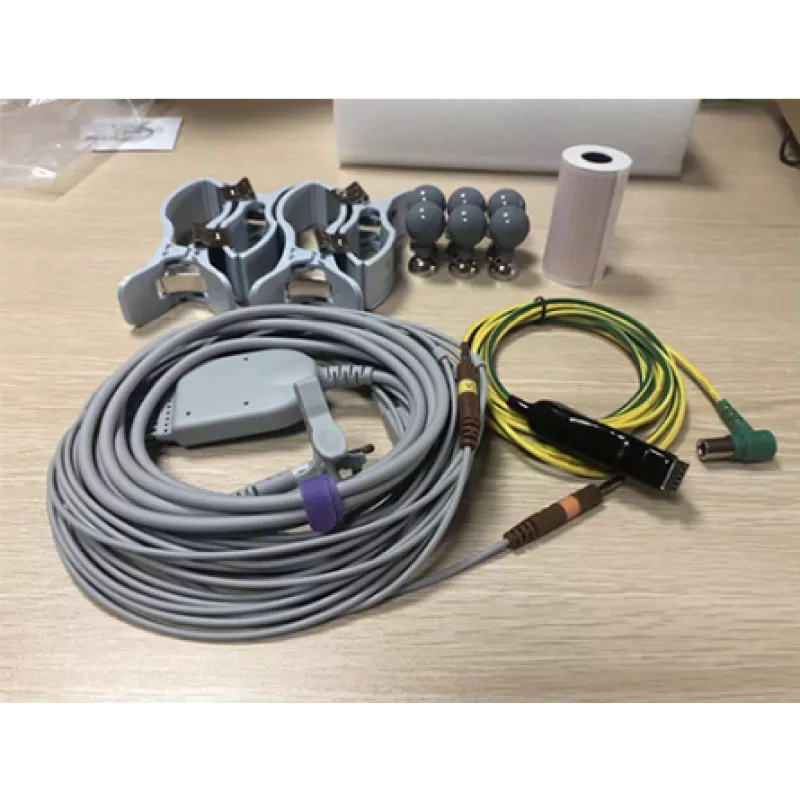When it comes to monitoring cardiac activity with precision and reliability, dynamic ECG systems play a crucial role. Two prominent products in this field are the 6 Channel Smart Hospital ECG Manufacturing Machine Monitoring Dynamic Holter ECG Systems YR05161 by Kalstein, and the Dynamic ECG Systems SEER 1000 by GE Healthcare. Despite both being high-end products designed for monitoring electrocardiograms, subtle differences in design, functionality, and user experience set them apart in competitive ways.
The 6 Channel Smart Hospital ECG Systems YR05161 by Kalstein offers a state-of-the-art solution for hospital settings, integrating sophisticated algorithms for real-time cardiac monitoring. This system boasts a full disclosure of every heartbeat, ensuring that no event goes unnoticed. On the other hand, SEER 1000 by GE Healthcare is known for its robust design and user-friendly interface, providing steady performance in various clinical environments. While both devices are designed for meticulous cardiac analysis, the SEER 1000 leans more on ease of use, while the Kalstein model shines with its advanced monitoring capabilities.
| Feature | Kalstein 6 Channel Smart Hospital ECG YR05161 | GE Healthcare SEER 1000 |
|---|---|---|
| Channels | 6 | 3 |
| Portability | Moderate | High |
| Real-time Monitoring | Yes | Yes |
| Data Storage | Extensive | Limited |
| User Interface | Complex | User-friendly |
| Battery Life | Long | Standard |
How They Function
The Kalstein ECG system utilizes six channels to capture wide-ranging cardiac data, applying advanced algorithms for accurate and continuous monitoring. Designed mainly for hospital use, it provides extensive data storage capabilities, making it optimal for long-term observations. Conversely, the GE Healthcare SEER 1000 integrates a smaller, portable design with three channels for easier deployment across various settings, perfect for on-the-go data collection.
Intended Use
The Kalstein 6 Channel Smart Hospital ECG is intended for detailed cardiac monitoring in healthcare settings. It serves to identify and alert clinicians to any cardiac event, whether routine or abnormal, ensuring timely medical intervention. It excels in environments where accuracy and comprehensive data are paramount.
Types
Both Kalstein and GE Healthcare provide various models within their ECG systems, designed for differing clinical demands. Kalstein focuses on comprehensive hospital solutions, while GE Healthcare offers more portable, user-friendly models, catering to diverse clinical settings from in-hospital care to ambulatory services.
Market Price
The Kalstein ECG system is competitively priced, reflecting its advanced capabilities and extensive features. In the market, prices for such high-tech medical equipment vary widely, often ranging between $2,000 to $5,000 depending on the features and technology incorporated. The GE Healthcare SEER 1000, given its portability and ease of use, also falls in a similar price range, making both systems value-driven choices for institutions seeking quality cardiac monitoring tools.
Frequently Asked Questions
What is a dynamic Holter ECG system?
A dynamic Holter ECG system is a device used for continuous recording of heart activity, typically over 24-48 hours. It helps identify any irregularities in heart rhythm that may not occur during a standard ECG.
How important is channel number in ECG systems?
The number of channels in an ECG system affects the amount of cardiac data that can be captured and analyzed. More channels generally provide more comprehensive data.
Is the Kalstein ECG system suitable for all hospital sizes?
Yes, the modular design and comprehensive features make it suitable for both small clinics and large hospital settings, providing scalability in its application.
Advantages and Disadvantages
The Kalstein ECG system offers several advantages, including superior data storage, high-resolution monitoring, and versatility in hospital environments. However, its complex interface might require additional training for new users. On the flip side, while the GE Healthcare SEER 1000 is highly portable and user-friendly, its limited channels and data storage capacity may restrict its use in large-scale monitoring projects. Ultimately, the advanced features of the Kalstein system provide a deeper, more reliable analysis of cardiac functions.
Field Use
In practice, the Kalstein ECG system is employed predominantly in hospital settings, offering continuous cardiac monitoring and crucial data for patient management. Its complex analytics driven by multi-channel input facilitates a more thorough diagnostic process, essential for critical care decision-making. On the contrary, the SEER 1000 shines in outpatient and remote settings, allowing easy data collection and review.
Recommendations
To maximize the utility of the Kalstein 6 Channel ECG system, ensure regular software updates to maintain optimal performance and accuracy. Regularly check and maintain the device’s components, such as sensors and batteries, to ensure uninterrupted use. Familiarize the staff with its operational interface to fully exploit its advanced features. Consider integration with Kalstein Plus for automated quotations and efficient procurement processes.
If you are looking for a blend of innovation and quality, you have come to the right place. At Kalstein, we offer you the luxury of exploring our exclusive laboratory equipment catalog. We manufacture each piece of equipment with a level of excellence. Our intuitive and agile online shopping channels are designed for your convenience, ensuring the most user-friendly prices. Don’t hesitate any longer, we bring science to life; it’s time to become part of our community. https://kalstein.us/product/6-channel-smart-hospital-ecg-manufacturing-machine-monitoring-dynamic-holter-ecg-systems-yr05161/.

